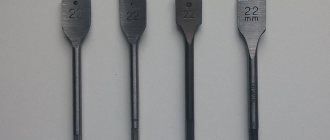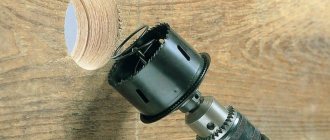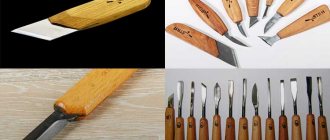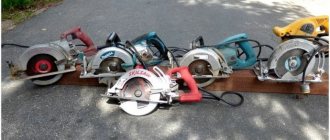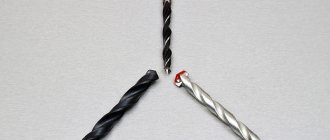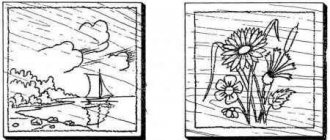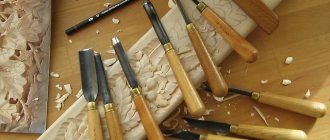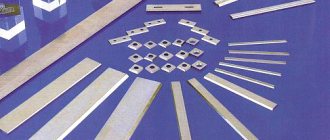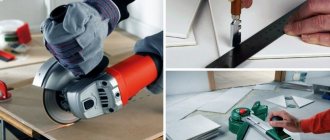Feather (feather) wood drills are used for drilling mainly through holes in wooden products. They differ in the shape of the cutting part, diameter, and sharpening of the blades. This tool is easy to use and affordable. When drilling wood, it can replace an expensive disk cutter.
Application area
The tool is used when working with all types of wood, as well as its derivatives (MDF, chipboard, plywood). It is equally widely used for repairs, in the manufacture of furniture, doors, window frames, and in other areas of industrial production. There are two main types of drilling in which it is used:
- For non-through holes of small diameter. For example, the production of fastening sockets for door jambs, furniture production.
- For through holes. For example, sockets for installing studs and other fasteners.
Important! Spade wood drill bits are recommended for shallow drilling. You also need to remember about the thin tip. It goes deeper into the wood than the main head.
Let's talk about "feathers" on wood
Very often, home craftsmen use feather drills to drill wood, both regular and laminated wood. What are their advantages and disadvantages - read in this article.
A feather drill (hereinafter referred to as a feather drill) is used when drilling large-diameter holes in wood, the most important thing here is that the quality of the cut should not worry the master, the edges of the hole turn out to be a little uneven and “hairy”. However, if you need to lay a water pipe from the underground into the house through a floorboard, then you won’t find a better drill, I mean price-quality.
This type of consumable is several times cheaper than a screw drill and is better suited for one-time work.
Of course, you can also drill large diameter holes using a Forstner drill, but note that a Fosner will not be able to drill deep. The length of the “feather” is approximately 18 cm, while the Forstner drill is very short, 10 centimeters, and yet it is more suitable for drilling finishing holes of large diameter (up to 60 mm).
Forstner drills cleaner, perka - the edges are “hairy”.
The advantages of this consumable:
- Low price (compared to other wood drills)
- Many diameters (choose for your work)
- Versatility (people even drill sheet metal/tin with them)
- It is possible to extend the drill by another 300 mm
The wood chisel has a center, which is used for initial penetration into the tree, and 2 cutting teeth along the edges, which outline a circle and cut along the circumference. It is very easy to drill with it, especially if the diameter is required up to 30 mm. Above 30 mm, drilling is already worse. To work, you will need a regular drill, even with a low power of 500 watts. You can also drill with shurik and perfach.
In the video below, the master is working with different types of perks, all of them made from Soviet ones with a thick shank. But these are no longer available for sale))
The size range of feathers starts from 10 mm and ends with a rather large diameter of 60 mm. If you need to drill a hole larger than 60 mm, then hole saws, the so-called crowns, will come to your aid. Of course, their cost will be higher, all because they usually come in sets.
How to increase the drilling depth with a pen?
The answer is simple - on sale you can find special extension cords that cost around 100 rubles, but are suitable for most sizes. They look like this:
We inserted the percussion, clamped it with a 3 mm hex key and we were ready to work. The length of this extension is 300 mm. Of course, for drilling deep, large-diameter holes, it is better to use screw drills, since a drill with an extension is a flimsy design, needless to say.
Well, we note that special jigsaw files designed for curved sawing will also help us in cutting out large diameters in wood. You simply first drill the board with a regular drill for wood or metal (diameter 5-6 centimeters), then insert a jigsaw file and start sawing in a circle. Of course, it will be difficult to cut out a perfectly round hole with a diameter of less than 80 mm with a jigsaw, but what to do if you have no choice.
Design features
The uniqueness and efficiency of feather drills lies in their design simplicity. They consist of two parts:
- The working part is the main part of the tool that comes into contact with the wood being processed. The shape resembles a shovel with a sharp tip. He is responsible for the exact position of the blade and cuts out the main part of the wood. On the sides of the working surface there are blades and cutting edges. If you look at the longitudinal section, they are sharpened to the right side.
Feather drills for wood are made according to strictly verified patterns. The proportional ratio of the width and thickness of the working part is strictly observed:
| Width (diameter) | Thickness |
| Up to 1 cm | Up to 2 mm |
| Up to 2 cm | Up to 4 mm |
| Over 2 cm | Up to 8mm |
- tail - a steel rod in the shape of a hexagon. The multi-faceted configuration allows you to securely attach it to the drill chuck, as well as use adapters to increase the working depth.
How to sharpen a tool?
Judging by reviews from owners, sharpening feather cutting tools is not difficult.
To work, you will need a diamond wheel mounted on a sharpening machine. If such equipment is not available, the home craftsman can use the quality rule. The sharpening procedure will be easy and quick if you follow the following sequence:
- Prepare a previously unused cutting attachment. It will be used as a sample.
- During sharpening, you need to periodically check the cutting attachment being processed with the geometric parameters of an unworn new tool.
When aiming the cutting edges of a pen drill, it is recommended to be as careful as possible. The main thing is that after sharpening the central protrusion of the tool is not damaged.
According to numerous reviews from experienced craftsmen, it is not always advisable to sharpen such products. Very worn feather drills with heavily ground cutting parts are considered waste material. Since such a tool is not very expensive, it is better to immediately purchase a new drill than to waste time and “plant” the diamond wheel.
Characteristic
The most complete idea of the technical characteristics can be obtained in comparison with other types of attachments. There are three types of wood drill bits that seem to perform the same task. This is not entirely true:
- Spiral - designed for through drilling. It will not be possible to make a mounting socket using it. It is possible to obtain deep through holes of small diameter with smooth edges.
- Forstner drill - used to make shallow, large diameter holes. It is characterized by high cost. The shank is short, which limits the scope of application. The edges of the hole are smooth, without flaws.
- Feather - inexpensive, with a wide range of working diameters. There is an extension option. Convenient, easy to use. Suitable for all types of wood. With a drilling diameter of more than 60 millimeters, creases and torn edges are possible.
Feather drills for wood outperform their competitors in many ways. The only drawback is uneven edges with a large drilling diameter, but this is not worth paying attention to. You need to know that high-quality large-diameter holes are drilled with crowns.
Feather drill
Feather drills are consumable tools designed for drilling in wood, plastic, drywall, ceramics, and glass.
The feather drill has its own original appearance, which cannot be confused with any other type of drill. By design, it is a metal rod, one edge of which has a hexagonal end, and on the other side there is a working part of the drill called a feather. The feather itself has a spatula-shaped appearance, with an incisor emanating from it.
Feather drills come in two types:
- for woodworking (image above)
- on ceramics and glass.
The feather drill bit for drilling glass and ceramic tiles looks like this:
Feather drills for wood
Since we have a roofing portal, we are interested in feather drills designed for working with lumber and other wood materials.
In terms of quality and accuracy of work, these drills are imperfect and have their own advantages and disadvantages. They are used mainly for rough operations.
Feather drills stand out due to their high productivity. Of course, the ease of drilling directly depends on the hardness of the wood and not all tree species are easy to drill. But with lumber widely used in construction, a feather drill can easily cope with drilling. It is often used for drilling large diameter holes when working with laminated wood and can even be used when working with plasterboard and plastic.
Feather drills for wood are single-sided and double-sided. Accordingly, they are designed to work with rotation in one and two directions, respectively. The cutting angle of a single-sided pen cutter is 75-90°, and that of a double-sided pen is 120-135°.
Workmanship
Like any other tool, the quality of the drill and its service life directly depend on the raw material and the method of its processing. Visually, the quality of drill processing can be determined by its color:
- Steel gray shade - The drill part has not been processed (can be painted with colored paint);
- Dark - The drill is treated with live steam to increase the strength of the metal (it can also be painted with colored paint);
- Golden - A special technology for processing the drill part is used;
- Bright golden - The surface of the drill has a layer of titanium nitride, which increases service life and strength characteristics.
Currently, there are a large number of manufacturers of feather drills. In order not to make a mistake in choosing a drill, when purchasing you should pay attention to:
- shape – the drill tip should be symmetrical;
- the cutters on the drill must be perfectly straight;
- absence of chips and irregularities on the drill;
- material and manufacturing processing of the product.
Dimensions of feather drills for wood
The size of the pen drill is indicated in millimeters. It is indicated on the drill bit.
Size range from 10 to 60 mm.
Feather drills are sold in sets and individually. The most common sizes (10, 12, 16, 18, 20 and 25 mm) are supplied with drill sets. Feather drills larger than 25 mm are usually sold individually.
You can order a drill of any size in the range from 10 to 60 mm. It is not reasonable to produce and use feather drills larger than 60 mm. Due to the large drilling area, the cutters are difficult to cut wood.
The length of the feather drills is 150 mm. If this length is not enough for the job, you can use the same extension cord that is used for screwdriver bits:
Pros and cons of feather drills
The feather drill has a number of advantages. Of course, the main one is the price of the drill. Spade drills are much cheaper and have a fairly wide range of working diameters.
An even bigger advantage is the ease of sharpening the drill. A feather drill can be easily sharpened either with a regular flat file or with an electric sharpener.
Due to the hexagonal shape of the edge of the drill, the clamp in the chuck is more reliable, which prevents the drill from turning in the drill chuck.
The main disadvantage of pen drills is the lack of sizes above 60 mm.
The drill bits quickly become dull, which is why periodic sharpening is necessary.
Rules for working with a feather drill
The drilling process is performed in the following order:
- A mark is placed at the point where you need to drill;
- When drilling with a feather drill, it is advisable to use a drill with an adjustable speed. The speed (number of revolutions) directly depends on the size of the drill used. The larger the drill size, the less frequency the drill chuck should rotate. Drilling at high speeds leads to rapid wear of the cutters and possible breakage of the drill;
- An extension is used for drilling deep holes;
- It is advisable to start drilling at low speeds. This avoids the drill moving from the specified point;
- Since the drill is made in such a way that the wood chips do not come out and remain in the hole, it is necessary to periodically stop drilling and blow the chips out of the groove of the hole.
Sharpening a feather drill
Compared to all other types of drills, the feather drill is the easiest to sharpen. It can be easily sharpened with a flat file or emery.
When sharpening, it is advisable to take a new drill as a sample (to check the shape and angle).
Particular attention should be paid to the tip of the drill. It should be machined as much as possible in the center of the feather. A slight displacement of the tip of the tip relative to the axis of the drill can significantly complicate drilling (due to different lengths of the incisors).
If the working part of a drill is destroyed or severely deformed, then you should not waste time and effort on restoring it, but it is easier to buy a new drill.
Construction tool
A hammer is the most common tool in construction, used in a wide variety of…
Flexible tiles
If you don’t know the best way to cut bitumen shingles, this will be useful for you...
Construction tool
A nailer is a tool designed for driving fasteners (nails, staples, pins)…
krovli.club
Selection rules
Finding a high-quality nozzle at an affordable price is not so difficult. If we are talking about trusted companies, such as Bosch, Hitachi, then with a high degree of probability the product is of high quality and reliable. To determine the quality of drills from lesser-known brands, there are several rules that can be easily checked by visual inspection:
- Geometric dimensions. The cutting edges must be symmetrical to each other and be the same size.
- Quality of sharpening of cutting edges. It is checked by touching it with your finger, similar to checking the sharpness of the blade of a kitchen knife.
- The quality of the nozzle. Any irregularities in the working or tail part should alert you. Reliable products have an almost perfect sheen.
- Metal color. An important parameter to pay attention to first is:
Gray steel is highly likely to be completely untreated.
Black - the metal is calcined with steam. This treatment increases the strength and wear resistance of the nozzle.
Golden – internal stress has been removed from the metal. This significantly increases strength.
Bright golden – the drill is coated with a thin layer of titanium nitride. It will last a long time and will cope with the toughest wood.
Types of drills and coatings
Feather drills are divided into:
- One-sided. Cutting angle – 75-90o.
- Double-sided. Cutting angle – 120-135o.
Nozzles can be reinforced with certain coatings:
- titanium nitride (the most expensive option; resource increases by more than 5 times, characteristic bright golden hue);
- oxide film (protecting the nozzle from corrosion and overheating);
- steam treatment (increases strength; the metal becomes darker).
The tool without additional processing has the usual gray color of steel.
Features of operation
- Before starting work, the drilling area is carefully marked and clear boundaries are drawn. If there are many of them, then the depth of each is indicated.
- It is recommended to use a drill with variable speed control. This will make the job easier.
- The drill rotation range does not exceed 600 rpm. The golden rule is that the larger the hole diameter, the lower the head rotation speed and vice versa.
- An adapter is used to increase the drilling depth. One end of it is inserted into the cartridge, and the other into the tail section.
- The angle between the drill and the wooden surface is always 900. Otherwise, the tip may break and the workpiece may deteriorate.
- The main thing in work is the smooth increase in speed.
- Wood shavings are removed periodically.
Every craftsman should have feather drills for wood. They are easy to use. They are durable, productive, and easy to sharpen. The low price allows you to have several models of different sizes in stock.
Adjustable Spade Drill Cost
One drill replaces a whole set.
One small-diameter feather drill costs approximately 100-150 rubles. The cost of larger diameter drills reaches 300-400 rubles. The price varies depending on the manufacturer. Buying one universal drill will cost 1000-1500 rubles. Craftsmen advise saving on tools by purchasing such a drill, and note that it is convenient to use.
Did you manage to solve your problem using the recommendations from the article?
Yes!
46.43%
No. More answers required. I'll ask in the comments now.
38.42%
Partially. There are still questions. I'll write in the comments now.
15.14%
Voted: 799
Drill manufacturers
Modern, time-tested manufacturers:
- Bosch is one of the top three brands in the world for construction tools;
- Ruko – good value for money;
- Bison is a manufacturer with a good pricing policy and tool durability;
- Haisser – powerful tools for industrial needs.
Particular attention is paid to Soviet-made drills, as the most reliable and durable.
Today it is difficult to find such a tool, however, every professional knows that a tool marked “Made in the USSR” is always preferable.
